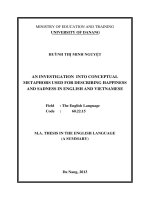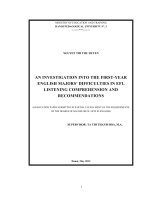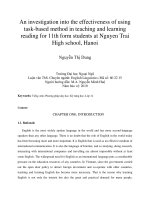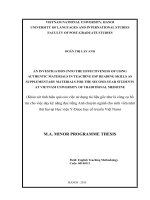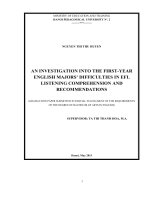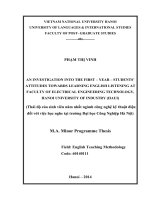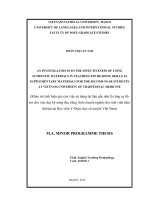An investigation into the current situation of using short term memory in english vietnamese consecutive interpreting of the third year english majors at vietnam national university of agriculture
Bạn đang xem bản rút gọn của tài liệu. Xem và tải ngay bản đầy đủ của tài liệu tại đây (1.4 MB, 67 trang )
VIET NAM NATIONAL UNIVERSITY OF AGRICULTURE
FACULTY OF EDUCATION AND FOREIGN LANGUAGES
BA THESIS
AN INVESTIGATION INTO THE CURRENT SITUATION OF
USING SHORT-TERM MEMORY IN ENGLISH VIETNAMESE CONSECUTIVE INTERPRETING OF THE
THIRD-YEAR ENGLISH MAJORS AT VIETNAM NATIONAL
UNIVERSITY OF AGRICULTURE
KHẢO SÁT THỰC TRẠNG SỬ DỤNG TRÍ NHỚ NGẮN HẠN
TRONG PHIÊN DỊCH NỐI TIẾP ANH - VIỆT CỦA SINH VIÊN
NĂM THỨ BA NGÀNH NGÔN NGỮ ANH TẠI HỌC VIỆN
NÔNG NGHIỆP VIỆT NAM
Student
: HOANG THI THUY LINH
Student code
: 621248
Major
: ENGLISH
Supervisor
: M.A NGUYEN THI HUONG
Hanoi – 2021
CERTIFICATE OF ORIGINALITY
I, the undersigned, hereby certify my authority of the study project report
entitled AN INVESTIGATION INTO THE CURRENT SITUATION OF USING
SHORT-TERM
MEMORY
IN
ENGLISH
-
VIETNAMESE
CONSECUTIVE
INTERPRETING OF THE THIRD-YEAR ENGLISH MAJORS AT VIETNAM
NATIONAL UNIVERSITY OF AGRICULTURE submitted in partial fulfillment of
the requirements for the degree of Bachelor in English Language. Except where
the reference is indicated, no other person’s work has been used without due
acknowledgement in the text of the thesis.
Hanoi, 2021
Linh
Hoang Thi Thuy Linh
Approved by
SUPERVISOR
(Signature and full name)
Date:……………………
i
TABLE OF CONTENTS
Page
CERTIFICATE OF ORIGINALITY................................................................. i
TABLE OF CONTENTS .................................................................................... ii
ACKNOWLEDGEMENTS ............................................................................... iv
ABSTRACT ......................................................................................................... v
LIST OF ABBREVIATIONS............................................................................ vi
LIST OF TABLES ............................................................................................ vii
LIST OF FIGURES .......................................................................................... vii
PART 1: INTRODUCTION.............................................................................. 1
1. RATIONALE FOR THE STUDY .................................................................. 1
2. AIMS AND OJECTIVES OF THE STUDY .................................................... 2
2.1 Aims ................................................................................................................ 2
2.2 Objectives ....................................................................................................... 3
3. RESEARCH QUESTIONS ............................................................................... 3
4. SCOPE OF THE STUDY ................................................................................. 3
5. SIGNIFICANCE OF THE STUDY ................................................................. 4
6. DESIGN OF THE STUDY ............................................................................... 5
PART 2: DEVELOPMENT ............................................................................... 7
CHAPTER 1: LITERATURE REVIEW .......................................................... 7
1.1 REVIEW OF PREVIOUS STUDIES (AT HOME/ABROAD) ..................... 7
1.1.1. Vietnamese Research ................................................................................ 7
1.1.2. Foreign Research ..................................................................................... 10
1.2 REVIEW OF THEORETICAL BACKGROUND ....................................... 11
1.2.1. Short-term memory (STM) .................................................................... 11
1.2.2. Consecutive interpreting ........................................................................ 14
CHAPTER 2: METHODOLOGY ................................................................... 21
2.1. RESEARCH GOVERNING ORIENTATION ............................................ 21
2.1.1. Research questions .................................................................................. 21
ii
2.1.2. Research types: ........................................................................................ 21
2.2. RESEARCH METHODS............................................................................. 22
2.1.1. Quantitative research methods .............................................................. 22
2.1.2. Qualitative research methods ................................................................ 23
2.1.3. Data analysis method .............................................................................. 23
2.3. RESEARCH SETTING/CONTEXT ........................................................... 24
2.4. DATA COLLECTION................................................................................. 24
2.4.1. Data collecting instruments .................................................................... 24
2.4.2. Data collecting procedures ..................................................................... 26
2.5. SUMMARY ................................................................................................. 27
CHAPTER 3: FINDINGS AND DISCUSSION ............................................. 28
3.1. FINDINGS AND DISCUSSION ................................................................. 28
3.1.1 The student’s personal information ....................................................... 28
3.1.2 The current situation and awareness of short-term in English to
Vietnamese consecutive interpreting ............................................................... 31
3.1.3 The difficulties in practicing short-term memory................................. 37
3.1.4 The student’s practice to improve short-term memory ....................... 39
3.2. SUMMARY ................................................................................................. 45
PART 3: CONCLUSION ................................................................................. 46
1. RECAPITULATION ...................................................................................... 46
2. CONCLUDING REMARKS .......................................................................... 47
3. LIMITATION OF THE STUDY .................................................................... 50
4. RECOMMENDATIONS/SUGGESTIONS FOR FURTHER STUDY ......... 50
REFERENCES .................................................................................................... 51
APPENDIX 1 ...................................................................................................... 54
APPENDIX 2 ...................................................................................................... 58
APPENDIX 3 ...................................................................................................... 59
iii
ACKNOWLEDGEMENTS
During the implementation of this thesis, I received plenty of
enthusiastic help and support that guided and encouraged me to overcome all
difficulties and finish this hard but meaningful time.
Firstly, I would like to convey my sincere thanks to my supervisor Mrs.
Nguyen Thi Huong, M.A, lecturer of the Faculty of Education and Foreign
Languages, Vietnam National University of Agriculture, for her whole-hearted
guidance and support. Without her valuable recommendations, this thesis
cannot come to an end.
Secondly, I sincerely thank all the Faculty of Education and Foreign
Languages teachers, Vietnam National University of Agriculture, for their
precious lessons during my four-year study, which have been the foundation of
this research paper.
Furthermore, I would like to acknowledge the encouragement and strong
support from my beloved family, especially my mother. Without their
excellent love and dedication, I would not do this thesis into reality.
I also want to express my most profound appreciation to my classmates
and friends for their heartfelt assistance and encouragement.
In short, I really thank all the people helping me to finish this thesis
successfully.
Hanoi, 2021
Hoang Thi Thuy Linh
iv
ABSTRACT
This paper discusses the short-term memory in English to Vietnamese
consecutive interpreting, intended for English majors at Vietnam National
University of Agriculture (VNUA), from the viewpoint of a fourth-year student
of the Faculty of Education and Foreign Languages, VNUA. The paper aims at
pointing out the specific difficulties of VNUA students’ use of short-term
memory in English – Vietnamese consecutive interpreting, and through which
learners will gain a deeper understanding of short-term memory, the critical role
of short-term memory skills; ... Therefore, several essential techniques to
effectively improve short-term memory in English to Vietnamese consecutive
interpreting are proposed.
In achieving these aims, the paper surveys the current situation of VNUA
students’ use of short-term memory in English – Vietnamese consecutive
interpreting. The survey is carried and assessed under in four main areas: The
student’s personal information; The current situation and awareness of shortterm in English to Vietnamese consecutive interpreting; The difficulties in
practicing short-term memory; The students’ practice to improve short - term
memory. From the received results, this study would be a reference for students
and teachers and the library of the Faculty of Education and Foreign Languages
at VNUA. In particular, it can help improve the effective use of short-term
memory in the study and practice of interpreting skills as well as assist their
future job related to the interpreting field.
v
LIST OF ABBREVIATIONS
STM
Short-term memory
CI
Consecutive interpreting
PC
Processing capacity
LTM
Long-term memory
vi
LIST OF TABLES
Page
Table 2.1. Reasons for difficulties in short-term memory .................................. 37
Table 2.2. Types of information causing difficulty to remember ....................... 38
Table 2.3. Self-evaluation of interpreting work .................................................. 39
Table 2.4. Aids/ Techniques supported for short-term memory when
interpreting .......................................................................................................... 41
Table 2.5. The Methods adopted to practice short-term memory in
interpreting .......................................................................................................... 42
LIST OF FIGURES
Page
Figure 1.1: Gile Model for Consecutive Interpreting ......................................... 19
Figure 2.1. The student’s current level of English .............................................. 29
Figure 2.2. The student’s English listening skills rate ........................................ 30
Figure 2.3. Average length of information that can be remembered best .......... 31
Figure 2.4. Percentage of information remembered after the first listening ....... 32
Figure 2.5. Percentage of information remembered after the second listening ......... 33
Figure 2.6. Percentage of information remembered after the third listening ...... 34
Figure 2.7. Time needed to rearrange information before interpreting .............. 35
Figure 2.8. Way of remembering the source information ................................... 36
Figure 2.9. The Frequency of practicing short - term memory in interpreting .......... 40
Figure 2.10. The Efficiency of Short - term memory practice............................ 44
vii
PART 1: INTRODUCTION
1. RATIONALE FOR THE STUDY
With the explosion of science and technology, the 4.0 revolution
was born as an inevitable course of global economic development.
Parallel to the advent of this revolution is the integration of the world.
In the international integration trend, the need for mutual understanding
among countries worldwide has been increasing. However, the different
languages are a significant communication barrier between countries.
Being considered a bridge of human communicative interaction,
interpreting skills are the key to breaking these barriers. Thus, an
interpreting career is now becoming increasingly potential and
attractive. However, the work of interpreting is not only demanding but
also challenging. Interpreting is a compulsory subject of all English
majors globally, especially at Vietnam National University of
Agriculture (VNUA). It is considered as a complex and challenging
subject. To achieve the best results, not only do learners need to have
good English foundation knowledge such as grammar, vocabulary, …
but also possess extensive knowledge and understanding of culture.
Besides such aspects, it is necessary to have good techniques. One of
these should be short-term memory, which is a crucial key that decides
the interpreting task's success.
Memory is one of the significant elements affecting the process of
storing and conveying information. Lack of mnemonic capacities may
prevent people from getting access to sources of data quickly and
accurately. However, due to brain formation, humans cannot remember
everything they have heard or read, which is likely to be too complicated
1
or unnecessary for long-term use. Generally, there are two forms of
memory: long-term memory and short-term memory.
In this, the role of short-term memory is analyzed and highlighted
to encourage the best use of memory in the context of interpreting classes
at VNUA. Short-term memory is not only necessary but also obligatory
for learners of foreign languages. After four years of academic training at
the University, the target set by the Faculty of Education and Foreign
Languages as well as most English majors is to become proficient
translators and interpreters. However, due to the limitation of interpreting
training time which only consists of 4 credits, students do not have many
chances to practice and improve their short-term memory. Although some
learners can be aware of its essential role, many of them have not applied
this skill effectively. Therefore, it is vital to take up a short-term
interpreting training course. With this regard, the objective of this study is
for students of the Faculty of Education and Foreign Languages how to
use short-term memory in English - Vietnamese consecutive interpreting
in the most helpful way.
2. AIMS AND OJECTIVES OF THE STUDY
2.1 Aims
This study mainly focuses on finding the current situation of using
short-term memory in English – Vietnamese consecutive interpreting of
the third-year English majors at VNUA and giving some solutions to
improve short-term memory in English – Vietnamese consecutive
interpreting.
2
2.2 Objectives
The overall purpose of this survey is to investigate the following issues:
Investigate the current situation of using short-term memory in
English – Vietnamese consecutive interpreting of the third – year
English majors at VNUA
Propose some solutions to improve short-term memory in English –
Vietnamese consecutive interpreting.
3. RESEARCH QUESTIONS
Due to the aims, the study is conducted by two following questions:
1. What is the current situation of using short-term memory in English –
Vietnamese consecutive interpreting of the third – year English majors at
VNUA?
2. What are some solutions to improve short-term memory in English Vietnamese consecutive interpreting of the third-year English majors at
VNUA?
4. SCOPE OF THE STUDY
- Research subjects:
Short-term memory is beneficial and essential in interpreting;
however, it is a comprehensive and challenging skill. Therefore, to obtain
the most remarkable findings and enhance the effectiveness of the study,
it is scoped with one hundred and twenty (120) third-year English major
students at the Faculty of Education and Foreign Languages in VNUA
3
using short-term memory in English - Vietnamese consecutive
interpreting.
The total numbers of the third-year English majors: 120 students
-
•
K63ENGA: 28 students
•
K63ENGB: 19 students
•
K63ENGC: 22 students
•
K63ENGD: 23 students
•
K63ENGE: 28 students
Research objects:
This study focuses on the current situation of using short-term
memory in English – Vietnamese consecutive interpreting of the third –
year English majors at VNUA.
- Time: From January 2021 to July 2021
Note: They are selected because they have already learnt the course
of Interpretation. And in this course, they have already studied about the
theory and practice of using short - term memory in consecutive
interpreting.
5. SIGNIFICANCE OF THE STUDY
This project focuses on researching and learning about short-term
memory in consecutive interpreting. From that time forward, point out
specific difficulties for learners to grasp. As a result, learners will gain a
deeper understanding of short-term memory, the meaning of short-term
4
memory in translation, and how to use it efficiently and improve shortterm memory.
6. DESIGN OF THE STUDY
This study consists of following three parts:
-
Acknowledgements
-
Abstracts
-
List of abbreviations, graphs, tables, and figures
-
Part 1: Introduction
This part is the introduction of background, aims, scope, research
method, and organization of the study.
-
Part 2: Development
+ Chapter 1: The literature review
It provides the theoretical background for the study,
including
definitions
of
short-term
memory,
interpreting,
consecutive interpreting. The relationship between short-term
memory and English to Vietnamese consecutive interpreting is
provided in this chapter. Additionally, the author also shows the
role of short-term memory in interpreting, the relationship between
short-term memory and consecutive interpreting, and short-term
memory in English to Vietnamese consecutive interpreting. Many
previous Foreign and Vietnamese studies are included in this
chapter.
+ Chapter 2: Methodology
It focuses on the methodology used in the research including
the research governing orientation, data collection instruments,
participants, the procedures employed to carry out the research.
5
+ Chapter 3: Findings and Discussion
It reports and discusses the usage of short-term memory in
English to Vietnamese consecutive interpreting. It also presents the
results from the data collection through survey and interview.
-
Part 3: Conclusion
It summarizes the main issues raised in the study and suggests
several solutions, the limitations of the study as well as the
suggestions for further study.
-
References
-
Appendix
6
PART 2: DEVELOPMENT
CHAPTER 1: LITERATURE REVIEW
1.1 REVIEW OF PREVIOUS STUDIES (AT HOME/ABROAD)
1.1.1. Vietnamese Research
There have been many studies about short-term memory in general
as well as short-term memory in consecutive translation in particular:
Hue, Le Thi (2018) conducted a study about "How to use shortterm memory in English to Vietnamese consecutive Interpreting
effectively." This research aims to introduce the importance of short-term
memory for interpreting studies and find out the difficulties students face
when using memory in interpreting. More importantly, the study also
aims to present to the third-year English major students of the English
Department in Hanoi University of Business and Technology how to
improve short-term memory in support of effective interpreting to orient
students who begin to study this subject in the excellent manner of study.
After doing the research, she found that the current situation and students'
awareness of STM in English to Vietnamese consecutive interpreting, the
difficulties of using short-term memory, and teachers' crucial role in STM
application for a student's interpreting skill.
Besides, In the study “Short-term memory in English to
Vietnamese consecutive interpreting” of Van (2013), the author highlights
the critical role of short-term memory skill, find out the shortcomings and
difficulties of the third and fourth-year English major at Hai Phong
University’s English majors in learning and applying this skill. Therefore,
several essential techniques to effectively improve short-term memory in
7
English to Vietnamese consecutive interpreting are proposed. Moreover,
she gives a lot of useful memory training games. All procedures are
extremely helpful for everybody, especially English major students.
Short-term memory can be used effectively if we know how to practice it
with a good method.
Duong (2006) conducted a study about How to Improve Short-term
Memory in Interpreting at Hanoi University. This study investigated the
Application of Short-term memory in Interpreting, intended for the
English Department students, Hanoi University of Foreign Studies
(HUFS), from the viewpoint of a fourth-year student of the English
Department, HUFS. The paper aimed to analyze the benefits of using
short-term memory to interpret the study and, more importantly
effectively, suggest how to improve short-term memory in interpreting. It
has been pointed out to make the best use of short-term memory to
facilitate language learning is an issue considered in many eloquent
articles and publications. In the process of interpretation learning,
recognizing the usefulness of short-term memory as a tool to enhance the
language acquisition and the challenges posed to my peer learners of
utilizing this helpful tool, she strongly desires to help the students in
English Department in exploiting more techniques from short - term
memory. Additionally, she analyzed some valuable techniques which can
assist in training short-term memory, which includes listening
improvement, visual short-term memory improvement, retelling in the
source language, and mnemonic to memory:
8
First is improving listening, which aids in increasing short-term
memory capacity. To improve listening skills, two fundamental
approaches of auditory short-term memory training are comprehensive
listening and intensive listening. The appropriateness of the tapes is
determined by the individual as much as the input must be of high interest
about comprehensive listening. There is no pause or stop during the
listening process to attract listeners' concentration to encode information
and summarize the content after. And about intensive listening, it is
listening to specific details, then repeating the items as exact as possible.
Second is visual short-term memory improvement. Visual input
exposure approach and word performance was proposed. When applying
a visual input exposure approach, units of associated high interest pictures
can be rapidly flashed, often displayed for 3 seconds before a response is
requested. Thanks to short-term memory, visual processing can be
improved by asking trainees to name the pictures in sequence or
reorganize the pictures in proper order. And word performance method,
which uses a list of words (preferred in foreign language) in different
forms or parts of speech. At the simple level, trainees are asked to rewrite
as many words as possible.
The next technique is retelling in the source language (English).
According to this method, the instructor either reads or plays a recording
of a text of about 200 words for the trainees to retell in the same language.
The trainees should not be allowed to take any notes. In the first instance,
trainees should be encouraged to retell the text in the same words as the
original to the largest possible extent.
9
Mnemonic to memory is the last technique. Mnemonics are
methods for remembering information that is otherwise quite difficult to
recall. The basic principle of Mnemonics is to use as many of the best
functions of the human brain as possible to encode information. There are
5 Mnemonic Techniques and Specific Memory Tricks to improve shortterm memory: Acronyms (Formed by using each letter from the group of
words to form a new word); Sentences/ Acrostics (Like acronyms, the
first letters of each word are used to make a sentence in the easiest way to
remember); Rhymes and songs ( Use Rhyme, repetition, melody, and
rhythm to memory); Method of Loci (combine the use of organization,
visual memory, and association); and Chunking (decrease the number of
items held in memory by increasing the size of each item).
1.1.2. Foreign Research
Zhong (2003) analyzed the significant characteristics of Short-term
Memory (STM) and their implications for interpreters' memory training.
The author believes that interpreting is an STM-centered activity, which
includes encoding of information from the Source Language, storing of
information, retrieval of information, and decoding of information into the
target language. The training of STM skills is the first step in training a
professional interpreter. Tactics for memory training for interpreters like
retelling, categorization, generalization, comparison, shadowing exercises,
mnemonics, etc., are presented in this paper. From this analysis, the
author can conclude that effectively designed exercises could acquire
memory skills in interpreting. With a well-trained short-term memory,
interpreters are equipped with an effective tool for encoding and decoding
information. It is, therefore, advised that institutions of interpreter training
include "memory training" in the design of their courses.
10
Pedersen, E. S., & Dam, H. V. (2017) researched Short-Term
Memory in the Production Phase of Sight Translation. This article reports
on an empirical study on short-term memory in sight translation. The
present research aims to investigate the role of short-term memory in
what, for convenience of expression, will be referred to here as the
production phase of sight translation, even if source-text reception and
target-text production insight translation strictly speaking occur in
overlapping rather than separate phases. In line with the study results, the
hypothesis that guides the research is that sight translators need to draw
on their short-term memory to perform and monitor their target-text
production.
Because the study is about short-term memory in English to
Vietnamese consecutive interpreting, foreign researches related to this
topic are limited.
1.2 REVIEW OF THEORETICAL BACKGROUND
1.2.1. Short-term memory (STM)
1.2.1.1. Definition of the short-term memory
Before studying short-term memory (STM), it is necessary to
understand the definition of memory. Memory is essential to all our lives
so there are a lot of definitions for it. For example, “Memory is the means
by which we draw on our past experiences in order to use this information
in the present’ (Sternberg, 1999), “Memory is the process of maintaining
information over time.” (Matlin, 2005), “Memory is today defined in
psychology as the faculty of encoding, storing, and retrieving information
(Squire, 2009).
11
In short, memory is the mental activity of recalling information that
you have learned or experienced. Psychologists have found that memory
includes two important categories: short-term and long-term. Some
researchers (e.g Eugen Tarnow) have proposed that there is no real
distinction between short-term and long-term memory at all, and certainly
it is difficult to demarcate a clear boundary between them.
Robert G. Crowder. Memory & Cognition, 1993. 21 (2), 142-145,
indicated that short-term memory must surely exist in two senses:
Memory in the short term. First of all, people must be able to retain
information over brief intervals of time. This is beyond argument as a
general proposition, even though the necessity of verbatim memory in
psycholinguistics has recently come under interesting criticism by Potter
and Lombardi (1990). But, needing to retain information over brief
intervals really means that human beings require memory, not that it
needs to be a dedicated subsystem with different properties from other
subsystems.
Short - term memory, sometimes referred to as “primary” or “active”
memory, is the part of memory which stores a limited amount of information
for a limited amount of time, roughly 15-30 seconds (Zhong, 2001).
That is, short - term memory is a system for temporarily storing and
managing information required to carry complex cognitive memory.
Information is involved in short - term memory in three basic
processes (Mayer, 2003): (1) Recently processed sensory input; (2) Items
recently retrieved from long-term memory; (3) The results of recent
mental processing.
12
Those are different definitions; however, all of them refer to the
capacity for holding a small amount of information in a short period of
time and readily available state. Short - term memory allows recall of
information for a relatively short time (such as a few seconds to a minute)
without rehearsal.
1.2.1.2. Major characteristics of short-term memory
Firstly, according to the findings of Crowden (1982) regarding
Input of information, information enters the short-term memory as a result
of applying attention to the stimulus, which is about a quarter of a second.
Secondly, as mentioned above, the Capacity of short-term memory
is limited and small. There are three basic possibilities in short-term
memory:
It is seven items of information (give or take two). (Atkinson and
Shiffrin, 1968)
It is seven "chunks" – implied as an integrated piece of information.
(Miller, 1956)
It may be that the limiting factor is not the STM's storage capacity,
but its processing capacity. (indicated by other researchers)
Thirdly, by sharing the common feature of memory, it cannot be
avoided the loss of information in short-term memory. Some studies have
explained the reason why we forget information in the process. Keppel
and Underwood (1962) emphasized the interference which is other
information in the storage at the same time which distorts the original
information. According to Waugh and Norman (1965), existing
information is replaced by newly received information when the storage
13
capacity is full. Additionally, Baddeley, Thompson and Buchanan (1975),
supposed that information decays overtime.
Fourthly, in terms of Modality, to store information in short-term
memory, it must be encoded, and there are a variety of assumptions as to
how this operates. Short-term memory has three main possibilities:
(1) Acoustic (Phonemic) coding is rehearsing through sub-vocal
sounds (Conrad, 1964 and Baddeley,1966);
(2) Visual coding is, as implied, storing information as pictures rather
than sounds. (Posner and Keele, 1967);
(3) Semantic coding is applying meaning to information, relating it to
something abstract. (Baddeley, 1990 and Goodhead, 1999).
In conclusion, there are four main characteristics of short-term
memory related to four factors including input of information, feature of
modality, capacity of storing and information loss.
1.2.2. Consecutive interpreting
1.2.2.1. Interpreting
Interpreting has been defined in different ways by various scholars.
The term is usually called "interpreting" rather than "interpretation".
Mahmoodzadeh (1992) gives a detailed description about
Interpreting: Interpreting consists of presenting in the target language, the
exact meaning of what is uttered in the source language either
simultaneously or consecutively, preserving the tone of the speakers.
14
To arrive at a convincing answer to the question: What is
Interpreting? Phelan (2001) classifies sight translation, translation of a
written text into spoken words, as a type of interpreting. Hence, in order
for the definition to include sight translation, we could define interpreting
as "rendering information from one language into speech in another
language".
While Pöchhacker & Shlesinger (2002) believes interpreting was an
"interlingual,
intercultural
oral
or
signed
mediation,
enabling
communication between individuals or groups who do not share, or do
not choose to use, the same language (s)".
Nevertheless, if we consider Suttleworth and Cowie proposes that
interpreting is "a term used to refer to the oral translation of a spoken
message or text." They add the history of interpreting is not well
documented, although it is generally agreed that, as an activity, it is older
than written translation. Thus, interpreting is transferring the messages
from source language into target language orally.
1.2.2.2. Consecutive interpreting
The classification of interpreting is concerned, consecutive and
simultaneous are the two sub-types of interpreting, based on the
interpreting mode used by the interpreter: simultaneous, which occurs
nearly at the same time as the original utterance of a speech; consecutive,
which follows a chunk of speech varying in length from very few
sentences to an entire speech lasting several minutes.
A more detailed picture of differences between the two main modes
of interpreting can be seen clearly with the definition given by Jones
15
(2002, p.56). He stated that a consecutive interpreter “listens to the totality
of a speaker’s comments, or at least a significant passage, and then
reconstitutes the speech with the help of notes taken while listening; the
interpreter is thus speaking consecutively to the original speaker, hence
the name.” And he explained the second mode as follows: “Here the
interpreter listens to the beginning of the speaker’s comments then begins
interpreting while the speech continues, carrying on throughout the
speech, to finish almost at the same time as the original. The interpreter is
thus speaking simultaneously to the original, hence again the name”.
From the above brief description, it is clear that the difference
between consecutive interpreting and simultaneous interpreting is the time
gap between the delivery of the speaker’s message and the beginning of
the interpretation. Whether working consecutively or simultaneously, the
interpreter must listen to the speaker, correctly understand and logically
analyze what is being said, and restructure the speech in an appropriate
equivalent in a different language.
Russell (2005) gives a more detailed description of Consecutive
interpreting (CI): “the process of interpreting after the speaker or signer
has completed one or more ideas in the source language and then pauses
while the interpreter transmits that information.” And Gonzalez et al.
(1991/2012) state that when using CI in the court setting, the duration of
the source language can be anywhere from a few seconds to several
minutes.
In short, consecutive interpreting is when the interpreter has to
listen to a speech in one language and translate it orally into another. Of
course, a time-lapse between the address and its interpretation is available.
16
The interpreter begins their interpretation of a complete message after the
speaker has stopped producing the source utterance.
1.2.2.3. Short-term memory and English to Vietnamese consecutive
interpreting
(1) Role of short-term memory in interpreting
Short-term memory is an essential part of the process of
interpreting. Depending on different modes of interpreting, Short-term
memory has different roles in the interpreting process; however, its role is
undeniable. When he gets input, the most important thing to the
interpreter is that he has to remember what he has just heard. He may
have excellent analyzing skills or professional public speaking capacity,
but he will have nothing to say if he does not remember what he has
heard. Thus, his interpretation fails. That is the reason why Phelan (2001:
4-5) mentions that “The interpreter needs a good short-term memory to
retain what he or she has just heard and a good long-term memory to put
the information into context. Ability to concentrate is a factor as is the
ability to analyze and process what is heard”. For interpreters, short-term
memory is extremely important because they cannot omit any part of the
source language. Thus, not only transferring skills but also memory is
necessary for interpreting.
(2) Short- term memory and consecutive interpreting
According to Gile's Effort Model (a Processing Capacity Account),
short-term memory is an essential part in the process of interpreting. It is
believed that interpreting is an STM-centered activity, which includes
encoding of information from the Source Language, storing of
17
